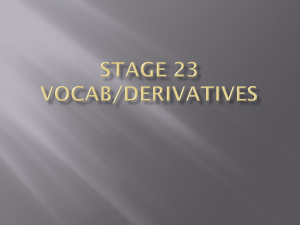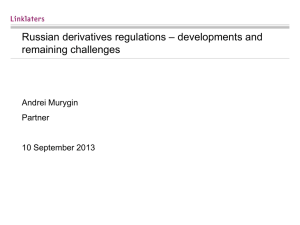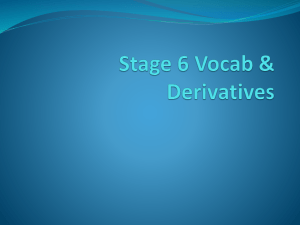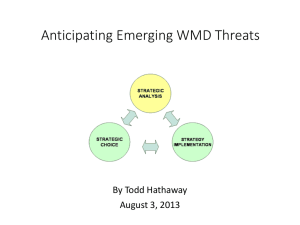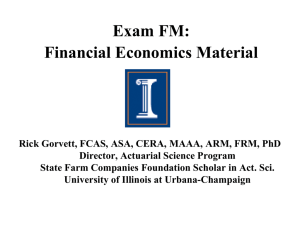Slides of IMF talk
advertisement
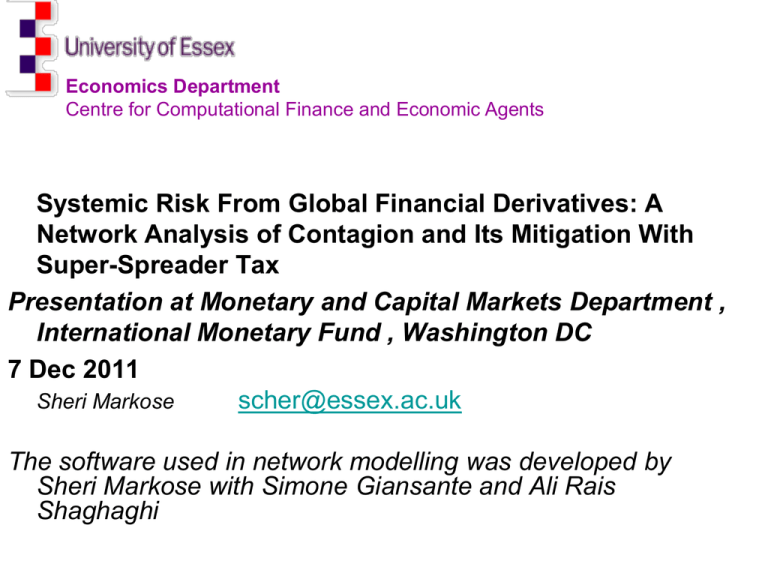
Economics Department Centre for Computational Finance and Economic Agents Systemic Risk From Global Financial Derivatives: A Network Analysis of Contagion and Its Mitigation With Super-Spreader Tax Presentation at Monetary and Capital Markets Department , International Monetary Fund , Washington DC 7 Dec 2011 Sheri Markose scher@essex.ac.uk The software used in network modelling was developed by Sheri Markose with Simone Giansante and Ali Rais Shaghaghi Roadmap: • Overview • New Office of Financial Research in the US Treasury to put an end to regulators flying blind • Financial Contagion and Systemic Risk :Statistical v. Structural Networks Model • Large Complex Financial Intermediaries and Global Financial Derivatives • Some technical details on Network Modelling • Topological Concentration: Too Interconnected to Fail (TITF) • Stability of Networks and Eigenvector Centrality • Internalizing Systemic Risk of ‘Superspreaders’ (Andrew Haldane 2009 idea operationalized by Markose (2011)) • Empirical Calibration of Global Derivatives Model and Financial Contagion • Furfine Stress Test • Superspreader Lite Escrow Fund • Results • Conclusions Banking Stability Index (Segoviano, Goodhart 09/04) v Market VIX and V-FTSE Indexes : Sadly market data based indices spike contemporaneously with crisis ; devoid of requisite info for Early Warning System Fallacy of Composition In the Generation of Systemic Risk/Negative Externalities: Holistic Visualization Needed Systemic risk refers to the larger threats to the financial system as a whole that arise from domino effects of the failed entity on others. Systemic risk from financial derivatives came to the forefront with growth in credit derivatives to about $60 tn at its peak in 2006 and with it the excessive liabilities on credit default swaps (CDS) of key institutions such as American Insurance Group (AIG) Tax payer bailouts ($14 Trillion) under the rubric of ‘too interconnected to fail’. Risk sharing in advanced economies uses O-T-C derivatives. At the level of the individual user these schemes appear plausible but at the macrolevel may lead to systemically unsustainable outcomes. Success of risk sharing at a system level depends on who is providing insurance and structural interconnections involved in the provision of guarantees. Only 5% of world OTC derivatives is for hedging purposes Credit Risk Transfer in Basel 2 gave capital reductions from 8% to 1.8% capital charge if banks got CDS guarantees from ‘AAA’ providers . Most of this held $674 Trillion Gross Notional Dec 2009 When compared to the size of world GDP at $70 tn, and size of the global bond market (total debt outstanding) at about $82 tn, the implication is that the size of off balance sheet activities of financial intermediaries (FIs) has grown to many multiples of their assets Procyclical derivatives obligations of FIs under conditions of market wide adverse movements on the underlying (such as interest rates, house prices, exchange rates, external debt of countries including sovereign debt) could overwhelm the equity and assets of FIs. Structure of Global Financial Derivatives Market (2009,Q4 202 participants): Green(Interest Rate), Blue (Forex), Maroon ( Equity); Red (CDS); Yellow (Commodity); Circle in centre Broker Dealers in all markets UK Fund Management 1984 and 2004 (Source Blake et. al 2010) Fund sponsors think they are diversifying by outsourcing to specialist fund managers: concentration and herding at system level Topological Concentration 2009 Fitch survey: “dependence on a limited number of counterparties looks to be a permanent feature of the market; this is underscored by the fact that the top 12 counterparties comprised 78% of total exposure in terms of the number of times cited, up from the 67% reported last year. The top five institutions that provided volume figures accounted for 95% of total notional amount bought and sold. This concentration increased after the collapse of a number of financial institutions who were important intermediaries in this market.” http://www.scribd.com/doc/37557210/Fitch-Market-ResearchGlobal-Credit-Derivatives-Survey-09162010 . These are Goldman Sachs, JP Morgan Chase, Barclays, Bank of America, Deutsche Bank, Morgan Stanley, Credit Suisse, BNP Paribas, UBS, Bank of America, Merrill Lynch, Royal Bank of Scotland. Notional amounts outstanding: Bns 70000 800000 60000 700000 600000 50000 500000 40000 30000 20000 Equity-linked contracts 400000 Commodity contracts 300000 Credit default swaps 200000 10000 100000 0 Gross market values (£bns) Foreign exchange contracts 0 6000 5000 Total contracts(right axis) Interest rate contracts(right axis) 40000 35000 30000 4000 3000 2000 Foreign exchange contracts Equity-linked contracts 25000 20000 Commodity contracts 15000 Credit default swaps 10000 1000 0 5000 0 Total contracts(right axis) Interest rate contracts(right axis) Total Value and Market Share of Financial Derivatives for Banks (1)The total value of financial derivatives is in billions of US dollars. (2) The market shares are in parenthesis. (3) Banks are ranked using Gross Notional Gross Notional All FIs 674.369 Gross Positive Fair Value (GPFV) Gross Negative Fair Value (GNFV) Derivatives Assets 10.465 Derivatives Liabilities Total Assets 0.889 37.252 Tier 1 capital 1.413 10.144 1.168 Top 16 FIs 659.263 (97.76%) 10.254 (97.98%) 9.934 (97.92%) Top 26 FIs 673. 827 (99.92%) 10.453 (99.89%) 10.134 (99.89%) 1.068 (91.39%) 0.816 (91.78%) 27.863 (74.80%) 1.014 (71.60%) 1.15 (98.52%) 0.874 (98.33%) 32.837 (88.15%) 1.207 (85.48%) Three major methodological issues:Why no dogs barked ? 1. Why was the need for macroprudential framework eschewed? Mainstream Neoclassical ‘Representative Agent’ Models; Unfortunate Irrelevance of Most State of the Art Monetary Economics (Buiter 09) 2.Why were there no system wide quantitative models developed for stress tests of how the financial network would function under these micro regulatory rules of individual bank behaviour? Failure of macro-econometric models for policy analysis (Lucas Critique);we have yet to replace this with multi-agent fine grained data base driven financial network models 3. Urgent need for modelling tools to monitor liquidity gridlocks,direction of an ongoing financial contagion, systemic risk : Multi-Agent Financial Network Models Answer: Lack of Complex Adaptive System framework- Red Queen type competitive co-evolution esp between regulator and regulatee requires constant vigilance and production of countervailing measures(Markose 2004, 2005) Robert Axelrod on Fragility of Communication Networks : Overlook Competitive Co-evolution Structural vs Statistical Contagion • DEFINITION: Economic and financial contagion refers to the spreading of a negative shock on the solvency conditions of an economic or financial entity in a physical supply chain or in terms of generic credit/debt and liquidity obligations governing interbank, payment and settlement systems and/or claims on other financial markets • Structural model based on default causality of chain reactions governed by the network connections of the financial entities • In contrast, models made popular by Kaminsky and Reinhart (2000) view financial contagion as the downward co-movement of asset prices across different markets and for different asset classes. This is based on statistical or econometric methods which measure (amongst other ways) the increased correlations of asset prices Above models complimentary to the causal default models that use financial network simulations, especially in the use of contagion models based on CDS price co-movements (Jorge Chan-Lau et al., 2009) • CDS Spreads based Statistical Models of Contagion Only quantitative assessment of FIs’ overall derivatives exposure and systemic risk impact : Sergoviano and Singh (IMF, 2010). Segoviano and Singh (IMF, 2010) :To quantify counterparty risk, estimate the probability that, given that a particular institution (counterparty) fails to deliver, other institutions in the system would also fail to deliver. Conditional probabilities quantifies Distress Dependence among the FIs that have obligations in the OTC derivative market. They use the CDS spreads on FIs to determine conditional probability of defaults Segoviano-Singh find that the expected cumulative derivatives losses when cascaded in a series of insolvencies of top broker dealers are even beyond the capabilities of the Fed Reserve to provide backstops. This adds urgency for the need to conduct an in-depth structural analysis of the financial derivatives and the role of large FIs. Key empirical variables derivatives liabilities and assets: involves derivatives payable by each FI with legally binding bilateral obligations netted over all OTC derivatives products and adjusted Financial network models to date have yielded mixed results : None about propagators of 2007 crisis (C: Core; P: Periphery PP below mostly zero yielding very sparse matrix) Properties of Networks Diagonal Elements Characterize Small World Networks Watts and Strogatz (1998), Watts (2002) See Markose et. al. (2004) Properties Clustering Coefficient Average Path Length Degree Distribution High Equal and fixed In-degrees to each node Networks Regular High Random Low Low Scale Free/Power Law Low Variable Exponential/ Poisson Fat Tail Distribution Some Network Concepts:A graphical representation of uncorrelated random graph (left) and small world graph with hubs, Markose et. al. 2004 Work Done by Sheri Markose and Simone Giansante for the Reserve Bank of India in mapping the financial system shows the following networks structures (PTO) • Top RHS Derivatives Exposures : Shows highly tiered Craig-von Peter (2011)core-periphery structure with large numbers of participants in the periphery and a few in the core • Top LHS Interbank Exposures: Shows a more diffused core with more numbers of banks in the core • Bottom: network for Indian RTGS (large value payment and settlement systems) shows no marked tiering with few financial institutions in the periphery • Above increasing seen as stylized facts for network structures in different financial sectors Financial Derivatives for the top 22 banks ($ billion) JPMORGAN CHASE Royal Bank of Scotland Bank of America Deutsche Bank Barclays Group PLC BNP PARIBAS Credit Suisse Morgan Stanley Goldman Sachs Citibank UBS Bank Global Credit Agricole HSBC Group Unicredit Lloyds Societe General ICE Trust U.S. Standard Chartered Dexia Wachovia bank Bank of New Gross Notional 78,665 (11.66%) 76,377 (11.33%) 72,529 (10.76%) 71,040 (10.53%) 61,144 (9.07%) 59,697 (8.85%) 44,550 (6.61%) 41,506 (6.15%) 41,118 (6.10%) 36,087 (5.35%) 28,013 (4.15%) 21,698 (3.22%) 14,477 (2.15%) 4,978 (0.74%) 3,784 (0.56%) 3,601 (0.53%) 3,302 (0.49%) 2,905 (0.43%) 2,629 (0.39%) 2,263 (0.34%) 1,275 GPFV 1,550 (14.81%) 690 (6.59%) 1,494 (14.28%) 867 (8.28%) 649 (6.21%) 522 (4.99%) 735 (7.02%) 928 (8.86%) 654 (6.25%) 706 (6.74%) 436 (4.16%) 351 (3.36%) 247 (2.36%) 110 (1.05%) 60 (0.58%) 254 (2.43%) 4 (0.04%) 38 (0.36%) 44 (0.42%) 66 (0.63%) 16 GNFV 1,517 (14.95%) 663 (6.53%) 1,462 (14.41%) 834 (8.22%) 628 (6.19%) 493 (4.86%) 734 (7.23%) 890 (8.77%) 591 (5.83%) 690 (6.80%) 424 (4.18%) 348 (3.43%) 248 (2.44%) 112 (1.10%) 50 (0.49%) 251 (2.48%) 4 (0.04%) 37 (0.36%) 46 (0.45%) 66 (0.65%) 17 Derivatives Assets 95 (8.16%) 106 (9.09%) 81 (6.91%) 100 (8.53%) 65 (5.57%) 60 (5.17%) 59 (5.07%) 49 (4.20%) 45 (3.88%) 87 (7.46%) 74 (6.31%) 70 (5.99%) 58 (4.95%) 89 (7.58%) 29 (2.51%) 0 (0.00%) 0 (0.00%) 8 (0.66%) 12 (1.00%) 29 (2.46%) 8 Derivative Liabilities 81 (9.15%) 81 (9.08%) 44 (4.91%) 67 (7.58%) 49 (5.49%) 31 (3.54%) 60 (6.79%) 38 (4.30%) 24 (2.71%) 53 (5.95%) 66 (7.45%) 57 (6.42%) 58 (6.53%) 90 (10.11%) 16 (1.77%) 0 (0.00%) 0 (0.00%) 6 (0.68%) 14 (1.52%) 9 (1.04%) 9 Total Assets 2,692 (7.23%) 2,379 (6.39%) 2,855 (7.66%) 2,156 (5.79%) 2,155 (5.78%) 2,956 (7.93%) 1,066 (2.86%) 773 (2.08%) 182 (0.49%) 1,764 (4.74%) 1,385 (3.72%) 2,237 (6.01%) 1,175 (3.15%) 1,334 (3.58%) 1,605 (4.31%) 1,150 (3.09%) 6 (0.02%) 437 (1.17%) 830 (2.23%) 997 (2.68%) 250 Tier 1 Capital 96 (6.82%) 98 (6.96%) 112 (7.92%) 49 (3.50%) 78 (5.49%) 90 (6.40%) 39 (2.80%) 47 (3.30%) 17 (1.21%) 97 (6.85%) 42 (3.00%) 45 (3.15%) 35 (2.51%) 56 (3.97%) 74 (5.26%) 35 (2.46%) 0.45,624 (1.38%) 25 (1.74%) 25 (1.79%) 40 (2.82%) 10 Financial Networks for the Derivatives Obligations: High Clustering from broker dealer behaviour and Barabasi et. al. Preferential attachment model very sparse matrix • Our algorithm assigns out degrees for a bank in terms of its respective market shares (siB/G) for Derivatives purchases(B) and sales (G), resp. Key is M Matrix of Netted elements of Gross Flow X Matrix below Data Federal Deposit Insurance Corporation (FDIC) Call Report 2009 4th quarter for smaller US banks treated as national associations Larger global banks data obtained from individual financial reports 204 x 204 matrix : 202 European and US banks & financial institutions + aggregation of all Insurance companies + exposure to all banks outside Europe and USA considered together Rows are gross negative fair value, i.e., market valued obligation from row bank to column bank JPMORGAN 0 BoA 222.913336 Morgan Stanley 138.374 221.42 0 124.155 116.339 104.958 100.795 Morgan Stanley 126.661 122.075497 0 70.7962 60.0402 57.6591 Deutsche Bank 118.784 114.4837229 71.0663 0 56.3063 54.0734 Credit Suisse 105.095 101.290621 62.8766 58.7422 0 47.842 CITIBANK 95.8675 92.39670082 57.3556 53.5843 45.4433 0 JPMORGAN BoA Deutsche Bank 129.276 Credit Suisse 109.635 CITIBANK 105.287 Units: Billions of dollars Constructing the network of bilateral exposures X= 0 221.42 126.66 118.78 105.10 95.87 … 222.91 138.37 129.28 109.64 105.29 … 0 124.15 116.34 104.96 100.80 … 122.08 0 70.80 60.04 57.66 … 114.48 71.07 0 56.31 54.07 … 101.29 62.88 58.74 0 47.84 … 92.40 57.36 53.58 45.44 0… … … … … …… M = X – XT : antisymmetric matrix of derivatives payables mij > 0 is net payables by node i from node j mji = – mij is corresponding amount by j to i Considering only matrix of +ve values, i.e., m+ij = mij if mij >0, mij= 0 otherwise we obtain the weighted adjacency matrix for the directed network M+ = 0 1.49 11.71 10.49 0 0 2.08 1.86 0 0 0 0 0 0 0.27 0 0 0 2.84 2.44 0 0 0 0 … … … … 4.54 3.67 0 0 0 0 … 9.42 … 8.40 … 0.30 … 0.49 … 2.40 … 0… …… links point from the derivatives net seller to the net buyer (the direction of contagion) Contagion and Stability of Matrix Θ’ : Impact of i on j relative to j’s capital 0 0 . ( x x ) i1 1i C1t . ( x x ) N 1 1N C1t ( x12 x21 ) C2 t . ( x13 x31 ) C3t ( x23 x32 ) C3t 0 . ... 0 ... . ... 0 . ... ... ( xNj x jN ) 0 .0. .... .... .... .... .... C jt ... 0 ( x3 N xN 3 ) C Nt . (2) ( xiN xNi ) C Nt . 0 Global Derivatives Market (Θ matrix) : JP and BoA central Tier; 22 other banks in Tier 2 all banks in the top tiers will fail if any other fails of this group We will use the rich club coefficient, (k) to identify highly connected nodes who form the club which is characterized by a fully connected network. The latter yields a coefficient of 1 and k# will denote the critical number of out-degrees the nodes need to have to be part of the largest sized rich club with (k) =1. Eigenvector Centrality A variant is used in the Page Ranking algorithm used by Google Centrality: a measure of the relative importance of a node within a network Eigenvector centrality Based on the idea that the centrality vi of a node should be proportional to the sum of the centralities of the neighbors is a constant The vector v, containing centrality values of all nodes is obtained by solving the eigenvalue equation Θ v = λmax v and selecting the eigenvector corresponding to the largest eigenvalue Positive values for the centralities are guaranteed by Perron-Frobenius thm: The eigenvector of the largest eigenvalue of a non-negative matrix Θ’ has only positive components. U0 with elements (u1t , u2t, ..... unt) = (1,0,......0) to indicate the trigger bank that fails at initial date, t=0, is bank 1 and the non-failed banks assume 0’s Dynamics of bank failures given by: Ut +1 = ´Ut - I (10) There are 4 ways in which stability of the financial network can be achieved (i)Constrain the bilateral exposure of financial intermediaries.This will only be successful relative to λmax (ii) Increase the threshold rho in (11), (iii) Change the topology of the network (iv)Levy a capital surcharge commensurate to the eigenvector centrality of a financial institution in (11). (i) & (ii) do not price in negative externalities and systemic risk of failure of highly network central nodes. Network topologies emerge endogenously and are hard to manipulate exogenously. Network Statistics –Scaling exponent (alpha) for outdegrees and for flows/exposures : those with higher connectivity have even higher liabilities (V1 204 nodes; V2 202 nodes) Connectivity Outdegree (V1) Clustering 0.018 0.48 Flows (V1) Outdegree(V2) Flows (V2) 0.013 0.45 Tail MaxExponent Xmin Likelyhood 2.1 1 -225.806 2.49 7.95 -167.081 2.15 1 -209.727 3.38 7.95 -97.2634 Rich Club Statistics Out Degree (k) k>0 k>1 k>2 k>3 k>4 k>6 k>7 k>8 k>9 k>10 k>12 k>13 k>16 Rich Club Coefficient 0.03 0.22 0.38 0.64 0.67 0.69 0.71 0.91 0.95 1 1 1 1 Number of Nodes(N(k)) 150 42 30 21 20 19 18 13 11 9 6 4 3 Too Interconnected To Fail : Stress Test • Objective: Build Network based on Θ’ and Conduct Stress Tests There is very high correlation between the dominance of market share in CDS and CDS network connectivity • Stress Tests: Follow Furfine (2003) Algorithm • The loss of derivatives cover/receivables due to the failed bank as counterparty suspending its guarantees will have a contagion like first and multiple order effects. Full bilateral tear up assumed; No possibility for Novation • There is a power iteration Θ’ q where q is the qth power of the netted matrix. At each q, weighted paths of length q between each i and j nodes is obtained • We use 6% reduction of core capital to signal bank failure Table 5 2009 Q4 Eigenvector Centrality (EVC) (for Top 20 FIs ranked by weighted EVC) Trigger Bank and membership of Rich Club* Tier 1 Capital Links(In&Out) EVC (unwted) EVC (wted) $ loss at q=1;6% threshold (0%) Goldman Sachs 17.15 33 (0.078) 0.26 0.39 3.97(20.20) Deutsche Bank JPMorgan Credit Suisse Morgan Stanley HSBC Group Societe Generale(0.38) Barclays Bank of America Standard Chartered (0.22) 49.42 96.37 39.49 46.67 23 (0.054) 71 (0.15) 16 (0.038) 33 (0.08) 0.25 0.31 0.20 0.26 0.32 0.31 0.30 0.30 13.93(27.01) 32.38(69.78) 11.28(33.01) 5.72(16.77) 35.48 10 (0.024) 0.15 0.30 39.73(66.17) 34.69 10 (0.023) 0.15 0.24 16.10(31.40) 77.56 21 (0.049) 0.26 0.23 20.42(40.96) 111.92 54 (0.13) 0.29 0.21 4 4 4 6 4 10 4 4 6 3 8 8 6 2 24.58 9 (0.021) 0.14 0.19 3.93(8.24) 0.26 0.18 8.89(24.34) Wachovia 39.79 21 (0.049) 0.16 0.17 9.82(25.12) Uni Credit 12 12.08(43.19) 30 (0.07) Lloyds 5 7 96.83 Credit Agricole 7 Conditional failure of FI when others fail 3 Citibank BNP Paribas Contagion of Trigger: FIs Failed q=1 90.37 44.53 74.27 56.07 21 (0.049) 10 (0.024) 10 (0.024) 5(0.012) 10 (0.024) 0.24 0.15 0.15 0.07 0.15 0.15 0.14 0.14 0.13 0.13 7.16 (28.07) 9.68 (42.44) 9.29(19.28) 15.88(25.97) UBS New York Mellon 42.32 5(27.31) 10.15 18 (0.042) 0.15 0.11 0(9.26) RBS 98.28 25 (0.059) 0.26 0.07 0.37 (5.70) 1 5 3 9 8 3 3 4 5 3 9 5 3 2 3 0 0 4 2 Dexia(0.22) 25.24 6 (0.013) 0.06 0.06 5.23(10.75) NB * Purple stands for the rich club coefficient (k>11)=1 ; Brown (k>9)= 0.95; Green (k>8)= 0.91 1 1 Contagion from JP Morgan (LHS; 12 direct counterparties) BoA (RHS; 7 direct counterparties ) Contagion from Deutsche Bank (LHS; 4 direct c-parties demised) Standard Charter (RHS; 1 direct cparty demises) Contagion when JP Morgan Demises in Clustered CDS Network 2008 Q4 ( Left 4 banks fail in first step and crisis contained) v In Random Graph (Right 22 banks fail !! Over many steps) Innoculate some key players v Innoculate all ( Data Q4 08) Socialization of Losses Sergoviano and Singh (IMF 2008) Based on March 2008 data, in the case of a single institution failure, the total loss could be as high as $300–$400 billion depending on the FI; but when cascade effects are taken into account, the total loss could rise to over $1,500 billion. Our 2009 Q4 results show direct domino losses $ 350.6bn constituting 25% loss of Tier 1 capital of banks ; this does not include non-banks or nonUS/European banks; on including latter capital losses closer to $750 bn A super-spreader lite tax fund can be designed of only $66 bn (see Table 7 to follow) to cover 1st tier of the rich club How to stabilize ?: Superspreader tax quantified : tax using Eigenvector centrality of each bank vi or vi^2 to reduce max eigenvalue of matrix from 1.48 Superspreader tax rate Table 7 Super-Spreader Tax Raised From Top 20 LCFIs (All columns other than EVC $bns) PTO Note EVC is Eigenvector Centrality ; Tax % = EVC x alpha; Tax$s= Tax Rate x Tier 1 Capital • Super-spreader fund works like an escrow account; amounts escrowed as in a CCP or by regulator to be disbursed when default occurs • Super Spreader Fund lite : Secure funds to cover max losses of 1st tier (q=1) from any trigger bank failure • Full stabilization for λmax < 1, costly implies tax rates of 77% of Tier 1 capital of Goldman Sachs etc Alpha 0.2 Bank Name T ier 1 Capital 0.3 0.5 EVC T ax% T ax $s T ax % T ax $s T ax% 1.00 1.5 T ax $s T ax% T ax $s T ax% 6.64 T ax $s T ax% T ax 9.96 0.77 13.28 Goldman Sachs 17.15 0.39 0.08 1.33 0.12 1.99 0.19 3.32 0.39 Deutsche Bank 49.42 0.32 0.06 3.20 0.10 4.80 0.16 7.99 0.32 15.99 0.49 23.98 0.65 31.98 JPMorgan 96.37 0.31 0.06 6.04 0.09 9.06 0.16 15.09 0.31 30.19 0.47 45.28 0.63 60.37 Credit Suisse 39.49 0.30 0.06 2.39 0.09 3.58 0.15 5.97 0.30 11.94 0.45 17.91 0.60 23.87 Morgan Stanley 46.67 0.30 0.06 2.80 0.09 4.20 0.15 7.00 0.30 14.00 0.45 21.00 0.60 28.00 HSBC Group 35.48 0.30 0.06 2.13 0.09 3.19 0.15 5.32 0.30 10.63 0.45 15.95 0.60 21.26 Societe Generale 34.69 0.24 0.05 1.64 0.07 2.46 0.12 4.10 0.24 8.20 0.35 12.30 0.47 16.41 Barclays 77.56 0.23 0.05 3.64 0.07 5.46 0.12 9.10 0.23 18.20 0.35 27.29 0.47 36.39 Bank of America 111.92 0.21 0.04 4.61 0.06 6.92 0.10 11.53 0.21 23.05 0.31 34.58 0.41 46.11 Standard Chartered 24.58 0.19 0.04 0.94 0.06 1.40 0.10 2.34 0.19 0.29 7.02 0.38 9.36 Citibank 96.83 0.18 0.04 3.52 0.05 5.29 0.09 8.81 0.18 17.62 0.27 26.43 0.36 35.25 Wachovia 39.79 0.17 0.03 1.38 0.05 2.08 0.09 3.46 0.17 6.92 0.26 10.38 0.35 13.84 BNP Paribas 90.37 0.15 0.03 2.70 0.04 4.06 0.07 6.76 0.15 13.52 0.22 20.28 0.30 27.03 Credit Agricole 44.53 0.14 0.03 1.27 0.04 1.90 0.07 3.17 0.14 0.21 9.50 0.28 12.67 Lloyds 74.27 0.14 0.03 2.09 0.04 3.14 0.07 5.23 0.14 10.45 0.21 15.68 0.28 20.90 Uni Credit 56.07 0.13 0.03 1.45 0.04 2.18 0.06 3.63 0.13 7.26 0.19 10.89 0.26 14.52 UBS 42.32 0.13 0.03 1.09 0.04 1.63 0.06 2.72 0.13 5.45 0.19 8.17 0.26 10.90 New York Mellon 10.15 0.11 0.02 0.22 0.03 0.33 0.05 0.55 0.11 1.11 0.16 1.66 0.22 2.21 RBS 98.28 0.07 0.01 1.35 0.02 2.03 0.03 3.39 0.07 6.77 0.10 10.16 0.14 13.54 Dexia 25.24 0.06 0.01 0.31 0.02 0.46 0.03 0.76 0.06 1.53 0.09 0.12 3.06 4.68 6.34 0.58 2 2.29 Conclusion :Systems are unstable and superspreader taxes aim to mitigate instability • Too interconnected to fail addressed only if systemic risk from individual banks can be rectified with a price or tax reflecting the negative externalities of their connectivity • Lessons to be learnt : Disease Transmission in scale free networks (May and Lloyd (1998), Barthelemy et. al : With higher probabilities that a node is connected to highly connected nodes means disease spread follows a hierarchical order. • Highly connected nodes become infected first and epidemic dying out fast and often contained in first two tiers • Cold comfort for financial networks as failure of superspreaders destroys bulk of Tier 1 capital and history as we know it is over ! • However, tiered systems easier to target and manage than uncorrelated random graphs • Innoculate a few rather than whole population; Strengthen hub; Reduce variance of node strength in dominant eigenvalue formula • Changes in eigenvector centrality of FIs can give early warning of instability causing banks Ongoing tests and Concluding Remarks • Derivatives do not complete markets; excessive use causes tail risk; extant size a threat • Super spreader tax and fund recommended over ad hoc breakup of banks • Can eigenvector centrality based on adjacency matrix ie. unweighted eigenvector centrality be a sufficient proxy ?; less information is needed • Capital for CCPs to secure system stability can use same calculations based on eigenvector centrality • Further stress tests for robustness of ICE to see if .0013% capital is sufficient • Slides overleaf underscore my strong belief that financial networks should be calibrated on the basis of empirical concentration and clustering Other Issues :Do Real World Financial Networks Satisfy Nash Equilibrium ? Babus (2009) states that in “an equilibrium network the degree of systemic risk, defined as the probability that a contagion occurs conditional on one bank failing, is significantly reduced”. The premise of too interconnected to fail is that the failure of a big bank will increase the failure of another big bank, which we find to be the empirical characteristic of the network topology of the derivatives market involving LCFIs, indicates that the drivers of network formation in the real world are different from those assumed in economic equilibrium models. Ballester et al (2006 Econometrica) Quadratic utility and Nash equilibrium of economic activity: (wi/Aggregate wi ) = (Ratio of Bonacich centrality of i to sum of BC ) No evidence of equality Ratios for top 20 banks by the Weighted Katzbonacich measure HSBC Group JPMORGAN Credit Agricole SOCIETE GENERAL Uni_Credit BANK_OF_AMER ICA Barclays_Group_ PLC Credit_Suisse WACHOVIA_BAN K Ratio of banks KRatio of banks K- Market share of B/Total K.B B / Total K.B. each bank for (unweighted) (weighted) derivatives liabilities 0.00886 0.012587 0.0968908 0.018661 0.011858 0.1034948 0.010081 0.010829 0.077865 0.006924 0.006087 0.010788 0.010333 0.0678722 0.0727396 0.017091 0.009603 0.0683279 0.010365 0.009543 0.009392 0.009269 0.0530993 0.0564319 0.008252 0.008922 0.0481663 University of Essex, Econ Dept WP Feb 2010 No. 683 Financial Contagion and Systemic Risk in Network Model of CDS and Other Credit Enhancement Obligations of US Banks (pdf version) [Abstract] Simulator link CDS Network Simulator http://www.acefinmod.com/CDS1.html
